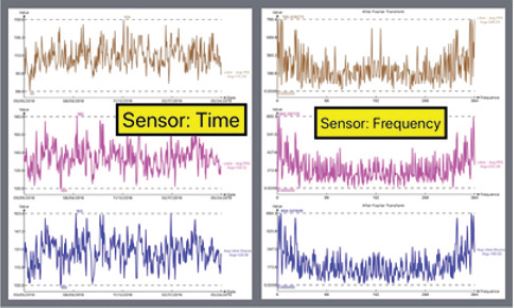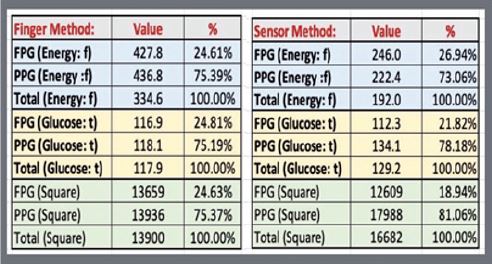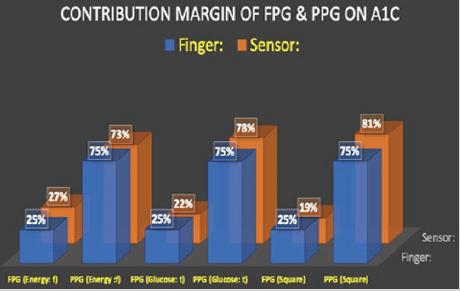Using GH-Method: Math-Physical Medicine to Investigate Different Contribution Margins of Fasting Plasma Glucose vs Postprandial Plasma Glucose on HbA1C
INTRODUCTION
This paper displays results of the contribution margin calculation of fasting plasma glucose (FPG) vs. postprandial plasma glucose (PPG) on HbA1C. The dataset is provided by the author, who uses his own type 2 diabetes metabolic conditions control, as a case study via the “math-physical medicine” approach of a nontraditional methodology in medical research.
Math-physical medicine (MPM) starts with the observation of the human body’s physical phenomena (not biological or chemical characteristics), collecting elements of the disease related data (preferring big data), utilizing applicable engineering modeling techniques, developing appropriate mathematical equations (not just statistical analysis), and finally predicting the direction of the development and control mechanism of the disease [1].
METHODS
The author has collected two sets of glucose data. The first set consists of finger-piercing (Figure 1: Finger) for a period of 1,484 days (5/1/2015 - 5/24/2019) with 5,936 data (four times a day, FPG, 3 PPG). The second set involves the continuous monitoring sensor (Figure 2: Sensor) for a period of 385 days (5/5/2018 - 5/24/2019) with 28,105 data (73 times a day).
Based on wave theory and energy theory of physics, he conducted detailed glucose analyses (Figure 3) using both timeseries (Time) and frequency-domain (Frequency) to calculate three sets of results:
(1) Average glucose in Time
(2) Energy based on square of glucose
(3) Energy from Y-axis amplitude of Frequency
RESULTS
As depicted in Figure 4, the summarized results are as follows:
FPG: Finger 25%, Sensor 19%-27%
PPG: Finger 75%, Sensor 73%-81%
The Finger method provides more precise percentages due to the limited collection of four data per day (25% vs. 75%), while the Sensor method provides wider ranges of percentages due to a bigger collection of 73 data per day [2].
For the past five years, the author has frequently performed “dynamic re-adjusting via trial-and-error” analysis of glucose margins. From those repetitive patterns, he has already observed the contribution margin of FPG at about 20-30%, whereas the input for PPG at about 70-80%. This paper’s sophisticated physical and statistical analyses have further reconfirmed his earlier findings [3- 5].
CONCLUSION
This analysis based on the GH-method: math-physical medicine can provide an accurate split of contribution margin between FPG and PPG. This knowledge on glucose is extremely practical and useful to help T2D patients on controlling their HbA1C.
REFERENCES
- Gerald HC (2018) Using math-physical medicine to control T2D via metabolism monitoring and glucose predictions. Journal of Endocrinology and Diabetes 1(1): 1-6.
- Gerald HC (2018) Using math-physical medicine to analyze metabolism and improve health conditions. Video presented at the meeting of the 3rd International Conference on Endocrinology and Metabolic Syndrome 2018, Amsterdam, Netherlands.
- Gerald HC (2018) Using Signal Processing Techniques to Predict PPG for T2D. International Journal of Diabetes & Metabolic Disorders 3(2): 1-3.
- Gerald HC (2018) Using math-physical medicine and artificial intelligence technology to manage lifestyle and control metabolic conditions of T2D. International Journal of Diabetes & Its Complications, 2(3): 1-7.
- Gerald HC (2018) A clinic case of using math-physical medicine to study the probability of having a heart attack or stroke based on combination of metabolic conditions, lifestyle and metabolism index. Journal of Clinical Review & Case Reports 3(5): 1-2.
Article Type
Mini Review
Publication history
Received date: April 13, 2020
Published date: April 27, 2020
Address for correspondence
Gerald C Hsu, eclaireMD Foundation, USA
Copyright
©2020 Open Access Journal of Biomedical Science, All rights reserved. No part of this content may be reproduced or transmitted in any form or by any means as per the standard guidelines of fair use. Open Access Journal of Biomedical Science is licensed under a Creative Commons Attribution 4.0 International License
How to cite this article
Gerald CH. Using GH-Method: Math-Physical Medicine to Investigate Different Contribution Margins of Fasting Plasma Glucose vs Postprandial Plasma Glucose on HbA1C. 2020 - 2(2) OAJBS.ID.000166.






